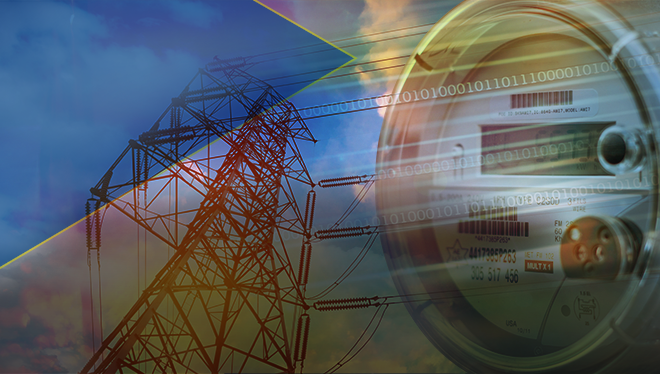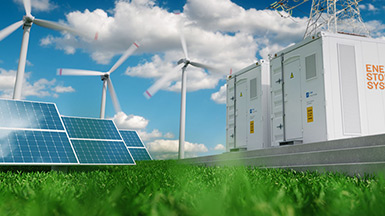

SIGNALS+ 在线快讯订阅
持续关注Signals+,了解有关连接、数字健康、电气化和智能工业的最新见解、信息和想法并加以利用。
ECOPHI’S AI-POWERED SUBSTATION AUTOMATION TACKLES A GRID UNDER PRESSURE
KEY TAKEAWAYSEcoPhi’s high precision, AI-driven technology leveraging ADI’s high precision technology, transforms grid substations into smart, automated, proactive nodes and provides:
|
Electricity grids worldwide are aging and becoming increasingly congested. Growing energy demand and the more complex operation in bidirectional EV charging, heat pumps, distributed energy resources (DERs), home energy management systems (HEMS), and AI and data center compute are posing unprecedented challenges for grid stability. Worldwide grid investment is forecasted to be >$2T between now and 2030. Better visibility into the existing grid is a necessity to operate smarter and avoid outages while grid upgrades continue.
THE PROBLEM WITH TRADITIONAL SUBSTATIONS
Substations act as the power grid’s middleman and were built to keep the grid balanced, taking electricity in at very high voltage—conditioning, switching, and routing it, so that it can be safely and effectively delivered.
The urgency to modernize substations stems from a hard truth: substations, the grid’s nerve centers, were designed primarily for protection, automation, and control of a unidirectional grid, whereas now we have a more complex bidirectional grid that demands responses to faults in real time. Every moment of downtime costs operators fines that can be substantial. The ideal substation system would have full visibility into the grid to anticipate or predict faults before they occur. For that, you need high quality data fast and real-time AI computation to find patterns and reveal insights buried deep in that data.

Traditionally, providing monitoring, protection, control, and automation for partial discharge (PD) and power quality (PQ) where relays require many separate hardware devices, extensive wiring, and complex commissioning.

Enter EcoPhi and its CEO and founder, Dr. Ebrahim Balouji, whose mission is to provide greater visibility into the grid and transform substations into smart, automated assets that detect and predict faults early on, saving operators costs, speeding up commissioning, and reducing cabling. To help bring his vision to life, Dr. Balouji sought Analog Devices, Inc.’s (ADI) technical expertise and high precision technology.
AT A GLANCE
COMPANY
EcoPhi provides industrial-grade grid- digitization tools, hardware, and AI software that transform substations into smart, efficient, automated, proactive nodes.
APPLICATIONS
EcoPhi integrates virtualized power quality (vPQ), virtualized partial discharge (vPD), and virtualized phasor measurement (vPMU), all-in-one box, the QMU 800. ADI’s provided high speed 24-bit ADCs, precision amplifiers, and high performance power.
CHALLENGE
Develop a high precision solution that enables an AI-powered smart grid to visualize behavior and predict faults before they occur.
GOAL
Digitize the power grid, enhance reliability, boost efficiency, and enable smarter decisions through real-time data and AI-driven insights.
Combining insights from two Ph.D. disciplines, monitoring, control, and AI and machine learning, EcoPhi’s Dr. Balouji aimed to develop an all-in-one digital platform: a virtual power-quality (PQ) monitoring, phasor measurement unit (PMU), protection, digital fault reporting (DFR), and partial discharge (PD) monitoring solution capable of intelligent, automated monitoring and actions with real-time predictive control.

“ADI and EcoPhi shared the same vision and understood the urgency needed to streamline the grid and improve and elevate substation operations as the backbone of a smarter power system, making it easier to engage,” said Christopher Murphy, Energy Field Technical Leader—EMEA, ADI.
With EcoPhi’s software-driven, high precision QMU 800, these functions can be consolidated, reducing field hardware for smart-grid protection, control, and PD/PQ monitoring by 80%. This was the core of Dr. Balouji’s daunting challenge.
PRECISION MEASUREMENTS TO RETRIEVE POTENTIAL INSIGHTS LOST IN THE NOISE
Just as each person in a crowd has a unique voice signature, electricity traveling through cable lines has its own signature. However, detecting these signatures, which reveal valuable information about the cable, transformers, and connected devices, is very difficult. That’s because they are weak, masked, and deeply buried in background noise.
This high frequency information cannot be measured using standard, low sampling speed, precision analog-to-digital converters (ADCs). So, EcoPhi turned to ADI’s market-leading ADC technology and high speed signal processing capable of detecting signals at extremely high sampling rates up to 2 MHz, with 24-bit full precision. ADI quickly worked with EcoPhi to complete the signal chain and helped to show them how to maximize cost efficiency, performance, and time to market.
“After analysis and consultation, our local account team recommended ADI’s best solution,” said Christopher Murphy. “That included ADI’s AD4030, a high speed 24-bit ADC, the ADA4945-1 precision amplifiers, and LTC7819 high performance power. In essence, the full signal chain.”
ANTICIPATING DEMAND AND PREVENTING DISRUPTIONS
Using AI, EcoPhi’s system could learn normal load profile patterns, such as a community’s morning start, midday dip, afternoon increase, and nighttime decline. By comparing real-time data to baseline patterns, the system could quickly identify anomalies. When a fault was predicted or detected, or demand suddenly surged, the system would alert another substation or power generator in a different region, enabling a warning and proactive measures: “An anomaly is forming. Expect a spike. Redirect additional power now!”
Alternatively, if urban planners wish to build an additional 5,000 homes in a region, the system could provide grid operators with insights into which transformers would be overloaded and what additional capacity is needed.
PREDICTING FAULTS
Detecting partial discharge (PD)—small electrical sparks caused by insulation damage or voltage irregularities—has traditionally required sensors, deployed along thousands of miles of cables. However, sending crews to locate faults, some buried in concrete or deep underwater, is expensive and inefficient. EcoPhi’s approach uses ADI’s high speed precision technology to detect harmonic content, employing AI to detect patterns and predict, with a high degree of certainty, if PD is likely to occur.
Faults are detected by EcoPhi’s QMU 800, an all-in-one “box” that sits in a rack at a substation. “It’s a virtual power quality meter application that gathers data in real time and can detect anomalies within milliseconds,” said Dr. Jakob Lindqvist, CTO, EcoPhi. “There‘s no longer a need to install and maintain dozens of physical meters to get a clear picture, and it offers seamless integration with cybersecurity and grid infrastructure protocols like IEC 61850."
EcoPhi Value Propositions1

THE FUTURE IS VIRTUAL
Enhancing grid visibility and addressing the energy challenge involves advancing substation automation through digitization, converting analog electrical signals into microsecond-level digital data for AI analysis. “We are rethinking how energy systems are monitored and maintained, giving operators the tools they need to act before issues turn into outages,” said Dr. Lindqvist. “By combining ADI’s advanced precision hardware with our software and intuitive AI, we help utilities optimize performance, cut costs, and move toward a more sustainable planet and intelligent energy future.”





